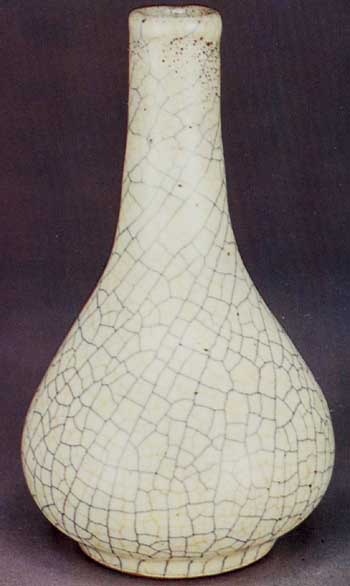

On 12 Nov 96, it was reported in the Qianjiang Wanbao (a newspaper in Hangzhou) that two gentlemen from the Zhejiang Province Collectors Society discovered the Xiuneisi Guan kiln site in a col between Wansong Mountain range and the Phoenix Mountain. The location is about 500 metres from the Southern Song Dynasty Imperial Palace. Large amount of sherds and kiln furnitures were found. On the base of two pieces of sherds, the words "xiuneisi" and "guan yao" was written in underglaze brown enamel respectively.
Since the discovery, much researches have been carried out by the ceramics experts in China but there is still no final conclusion on whether it is indeed the Xiuneisi Kiln.
Basically, Guan wares can be divided into those from Northern Song and Southern Song respectively. The Northen Song pieces consist of the celebrated Ru ware. It is believed that subsequently an imperial kiln was established at Kaifeng, capital of Northern Sung to produce Guan ware. However, this could no longer be established since the numerous floods caused by the Yellow river has buried the ancient site (if indeed it existed).
 |
 |
| Ru Ware | Xiunesi Guan Ware |
After the collapse of the Northern Song, Emperor Gaozong moved his capital to Linan (present day Hangzhou). According to Ye Zhi's Tan Zai Bi Heng, it is stated that after the court move to the south, an official by the name of Shao Chengzhang was appointed to set up kilns in accordance with the practice of the old capital and under the Xiuneisi Department (Department for the maintenance of imperial buildings, including imperial kilns) to produce porcelain wares to meet the needs of imperial court and the sacrificial rites; later, kilns were built at the foot of the Jiaotan (Suburban Altar). According to literature, the quality of the greenwares of Jiaotan were inferior to Xiuneisi kiln. A picture of a vase which is widely believed to be a product of Xiuneisi Kiln is shown on the right.
The Jiaotan Kiln located at the Wu Gui Mountain (乌龟山) was discovered in the 1930s. But ceramics experts of China could not locate the Xiuneisi kiln. Hence, there was a group of experts who questioned the existance of the kiln while another group firmly believe in its existance. In fact, some of them believe that Ge wares are actually Xiuneisi Guan wares. The Ge Wares is another unresolved mystery as the kiln that produced them have also yet to be discovered.
During a trip to Hangzhou in 1998, I acquired
some sherds which were recovered from a cigarette site near Wan Song ling. The sherds are of very high quality and the glazes are
in a varying tone ranging from honey to bluish color. Notice the
piece on the second picture, the glaze is much thicker than the biscuit
itself. It requires very higher level of sophistication in
the firing techniques to produce such wares.
Are those sherds really from Xiuneisi guan kiln? This could only be known after the chinese ceramics experts have concluded their studies.
Afternote on 12 Mar 2020: Chinese experts have carried out studies and concluded the site mentioned in the Qianjiang Wanbo, now termed Lao Hu Dong kiln (Tiger cave) site, is Xieneisi and the top layer was Yuan period Ge ware. However, Prof. Li Gang, the former curator of the Zhejiang Museum, still hold a different view. He is of the view that Tiger Cave should be Xu kiln (续窑) mentioned in the ancient text. It was of an official nature and was set up after Xieneisi was closed. He believes the location near the Cigarette site was the actual site of Xiuneisi. Unfortunately, the site has been demolished and no further exploration possible. His argument is cogent and merits further study. If we compare those sherds found at the cigarette site and those from the Tiger Cave site, the immediate reaction is the difference in quality. Those from the Cigarette factory site are of much better quality.
Interesting Chinese article relating the discovery of the cigarette factory finds:https://blog.artron.net/space.php?uid=1050737&do=blog&id=1341770
|
By: N
K Koh (20 Jul 2000)